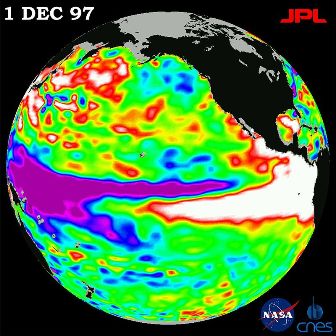Ancient Meteorologists Predicted El Niño
Genesis 1:14
“And God said, Let there be lights in the firmament of the heaven to divide the day from the night; and let them be for signs, and for seasons, and for days, and years:”
El Niños have been periodically changing the weather patterns of North and South America for thousands of years. El Niños in the Andes result in a four to six week delay in the rain needed for the potato crops on which ancient farmers depended. They even knew ahead of time when to wait to plant their potatoes for best results.
 Between June 13 and 24 of each year, these farmers would search the early dawn sky for the invisible signs of an El Niño. The warm El Niño waters cause more moisture to accumulate in the atmosphere. Some of this moisture forms invisible cirrus clouds high in the atmosphere. While invisible, these clouds would cause some of the more dim stars to disappear. So the Andean farmers looked to the northeastern horizon to find the Pleiades. If all seven stars, including the dimmest of them, shone clearly morning after morning, the Andean farmers knew that no El Niño was forming. However, if they consistently saw a dimming of the stars, they knew that they should delay planting for four to six weeks because the rains would be late.
Between June 13 and 24 of each year, these farmers would search the early dawn sky for the invisible signs of an El Niño. The warm El Niño waters cause more moisture to accumulate in the atmosphere. Some of this moisture forms invisible cirrus clouds high in the atmosphere. While invisible, these clouds would cause some of the more dim stars to disappear. So the Andean farmers looked to the northeastern horizon to find the Pleiades. If all seven stars, including the dimmest of them, shone clearly morning after morning, the Andean farmers knew that no El Niño was forming. However, if they consistently saw a dimming of the stars, they knew that they should delay planting for four to six weeks because the rains would be late.
Where would the Andean farmers learn the signs and consequences of an El Niño for their crops? The Bible teaches that the sun, moon and stars also serve to give us signs about the seasons. It would appear that God originally gave Adam the ability to read these signs, knowledge which Adam would have passed down to future generations.
Prayer:
I praise You, Lord, for the entire creation shows Your handiwork. Amen.
Notes:
Science Frontiers, 3-4/00, p. 1 “Archeometeorology.” Graphic: The 1997–98 El Niño observed by TOPEX/Poseidon. (PD)